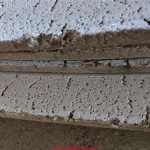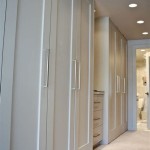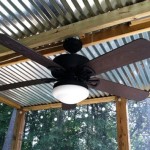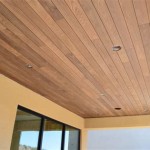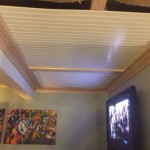The Benefits of Installing Faux Wood Paneling Ceilings
Faux wood paneling ceilings have become increasingly popular in both residential and commercial spaces. This material offers a versatile and cost-effective alternative to traditional wood ceilings, providing an aesthetic appeal while mitigating many of the drawbacks associated with natural wood. The installation of faux wood paneling ceilings presents a range of benefits, encompassing aesthetic enhancements, practical advantages, and economic considerations. Understanding these benefits is crucial for making informed decisions regarding interior design and renovation projects.
Faux wood paneling is typically constructed from materials such as PVC, vinyl, or composite wood, mimicking the appearance of various wood species like oak, pine, or cedar. The manufacturing process allows for a wide array of textures, colors, and patterns, enabling designers and homeowners to achieve a specific visual effect without compromising on durability or maintenance. This article will delve into the primary advantages of opting for faux wood paneling for ceilings, highlighting its impact on interior aesthetics, functionality, and overall value.
Aesthetic Versatility and Enhanced Visual Appeal
One of the most significant advantages of faux wood paneling ceilings is their remarkable aesthetic versatility. Unlike traditional wood, faux wood paneling can be manufactured to replicate virtually any wood grain, color, or texture. This provides a broad spectrum of design options to complement various interior styles, from rustic and traditional to modern and contemporary.
The consistent appearance of faux wood paneling contributes to a uniform and polished look, which can be difficult to achieve with natural wood due to variations in grain and color. This consistency is particularly beneficial in large spaces where maintaining a cohesive design is paramount. Furthermore, faux wood paneling can be molded into various shapes and sizes, allowing for creative ceiling designs such as coffered ceilings, vaulted ceilings, or intricate patterns. This level of customization enhances the visual appeal of the space and adds a touch of sophistication.
The ability to mimic exotic or rare wood species is another key aesthetic benefit. Natural woods such as mahogany or ebony can be prohibitively expensive and difficult to source. Faux wood paneling offers a cost-effective way to achieve the look of these high-end woods without the associated financial burden or environmental concerns. This makes luxurious design elements more accessible to a wider range of consumers.
Moreover, faux wood paneling can be treated with UV-resistant coatings to prevent fading or discoloration over time. This ensures that the ceiling maintains its original appearance for years to come, preserving the intended aesthetic of the space. In contrast, natural wood can be susceptible to sun damage, requiring regular maintenance and refinishing to retain its color and vibrancy.
The visual versatility of faux wood paneling extends to its ability to be integrated with other design elements. It can be seamlessly combined with lighting fixtures, ceiling fans, and other architectural features to create a cohesive and harmonious interior environment. The paneling can also be painted or stained to further customize its appearance and match specific color schemes.
Durability, Low Maintenance, and Enhanced Functionality
Beyond its aesthetic appeal, faux wood paneling offers significant advantages in terms of durability, maintenance, and functionality. Unlike natural wood, faux wood paneling is resistant to moisture, insects, and rot, making it an ideal choice for areas prone to humidity or temperature fluctuations, such as bathrooms, kitchens, and basements. This resistance to environmental factors significantly extends the lifespan of the ceiling and reduces the need for frequent repairs or replacements.
The low-maintenance nature of faux wood paneling is a major draw for many homeowners and business owners. It does not require sanding, staining, or sealing, as is often necessary with natural wood. Cleaning typically involves simply wiping the surface with a damp cloth to remove dust or dirt. This ease of maintenance saves time and money, making it a practical choice for busy individuals and commercial settings.
Furthermore, faux wood paneling can improve the acoustic properties of a room. Certain types of faux wood paneling are designed with sound-absorbing qualities, which can help to reduce noise levels and create a more comfortable environment. This is particularly beneficial in spaces such as home theaters, offices, or restaurants where noise control is important.
Fire resistance is another important functional benefit. Many faux wood paneling products are treated with fire-retardant chemicals, which can help to slow the spread of fire and provide valuable time for evacuation in the event of an emergency. This is a crucial safety consideration, especially in commercial buildings and multi-family residences.
The lightweight nature of faux wood paneling simplifies the installation process. It is easier to handle and install compared to heavy timber or solid wood planks, which can require specialized equipment and expertise. This reduces labor costs and makes it possible for some homeowners to undertake DIY installation projects. The interlocking or tongue-and-groove designs of many faux wood paneling systems further streamline the installation process and ensure a secure and seamless fit.
Additionally, faux wood paneling can provide insulation benefits. The material can help to regulate temperature and reduce energy costs by providing an extra layer of insulation in the ceiling. This is particularly beneficial in older homes or buildings with inadequate insulation.
Cost-Effectiveness and Environmental Considerations
The economic advantages of faux wood paneling are compelling. The initial cost of faux wood paneling is typically lower than that of natural wood, especially when considering high-quality hardwoods. This cost difference can be significant, making faux wood paneling a more budget-friendly option for large-scale projects or homeowners looking to renovate on a tight budget.
In addition to the lower initial cost, faux wood paneling also saves money in the long run due to its low maintenance requirements. The absence of the need for regular staining, sealing, or repairs translates to significant savings over the lifespan of the ceiling. This makes it a financially prudent choice for both residential and commercial properties.
The installation process is also more cost-effective. The lightweight and easy-to-install nature of faux wood paneling reduces labor costs. The shorter installation time minimizes disruption to the space, which is particularly important in commercial settings where downtime can impact revenue.
From an environmental perspective, faux wood paneling offers several advantages. It reduces the demand for natural wood, helping to conserve forests and protect ecosystems. The manufacturing process of faux wood paneling often utilizes recycled materials, further minimizing its environmental impact. By choosing faux wood paneling, consumers can contribute to sustainable building practices and reduce their carbon footprint.
Moreover, the durability and longevity of faux wood paneling contribute to its environmental friendliness. The extended lifespan of the ceiling reduces the need for frequent replacements, minimizing waste and conserving resources. This makes it a more sustainable option compared to materials that require more frequent upkeep or replacement.
The use of faux wood paneling can also contribute to improved indoor air quality. Unlike some natural wood products, faux wood paneling does not emit volatile organic compounds (VOCs), which can be harmful to human health. This makes it a safer choice for individuals with allergies or sensitivities.
Finally, the cost-effectiveness of faux wood paneling makes it accessible to a wider range of consumers, promoting sustainable building practices across different income levels. This democratization of sustainable design is an important step towards creating a more environmentally responsible built environment.

Faux Wood Ceiling Panels Texture Plus

Can You Use Wall Panels On The Ceiling Dbs Bathrooms

7 Reasons People Choose Fluted Panel In Their Home Pvc Wood Wall

Wood Look Ceiling And Wall Planks For Your Home Kanopi By Armstrong

Faux Wood Ceiling Panels Texture Plus

A Complete Guide To Using Wpc Ceiling Panels

Faux Wood Ceiling Panels Texture Plus

Beam Installation Techniques Mounting Blocks Plank Barron Designs

Faux Beam Ideas For Large House Decorative Ceiling Tiles Inc

Easy Shiplap Ceiling Installation In Kitchen Four Generations One Roof
Related Posts

